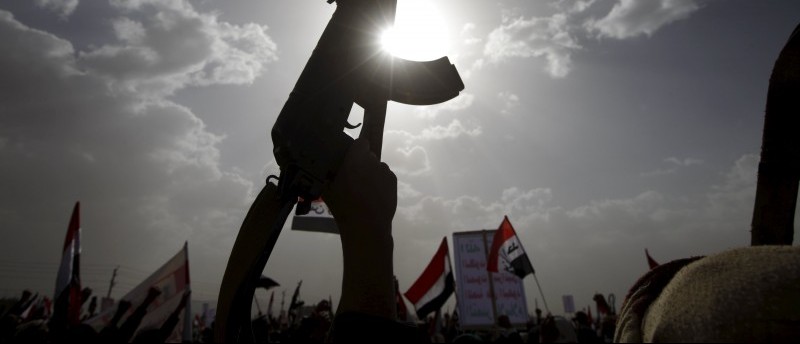
Syria is not the only chaotic Middle Eastern nation which may have to be broken apart to help calm a bloody civil war. Yemen might benefit from this as well.
Yemen originally was two separate states, and there was a good reason for that. The 26 million people in Yemen are exclusively Muslim, but they are divided largely into two religious sects – Sunni Muslim and Zaydi Shia Muslim. Zaydi Shias are not the same as the Shias found in Iran and Iraq. Roughly 65 percent of the Yemeni people are Sunni, and the other 35 percent are Zaydi Shia. After World War I, the British established a Zaydi majority Kingdom in the North, which later became the Yemen Arab Republic. South Yemen, which was overwhelmingly Sunni, was a separate state. Starting in the 1970s, Saudi influence grew, spreading the puritanical Wahhabism, or Salafism, among Yemen’s Sunnis. In 1990, the two Yemens united under the President of the Yemen Arab Republic, Zaydi dictator Ali Saleh. Soon after, the South, complaining of political and economic marginalization by the Zaydi government, attempted to secede, but was occupied by the North.
In 2011, the “Arab Spring” prompted protests in Yemen, which eventually forced President Ali Abdullah Saleh to step down. In 2012, a new President was elected – Abd Hadi, who had been serving as a Vice President and then Acting President. This election of a Sunni Muslim – and the aforementioned rise of Wahhabism – probably encouraged greater Zaydi support for the already existing Houthi rebellion. The Houthis are one of the largest and most powerful Zaydi Shia tribes in North Yemen.
Today, Yemen is a basket case of a nation, divided into many territories controlled by different warring parties. The Houthi militia, now working with the former President Saleh, has largely conquered the mountainous Northwest. Iran has taken advantage of their mutual Shia ties toprovide money, training, and weapons to the Houthis. In the South, Sunni Arab groups dominate, including the recognized government of President Hadi, now in Aden, the secessionist Southern Movement militia, and Al Qaeda in the Arabian Peninsula (AQAP), one of the deadliest branches of al-Qaeda, which controls more territory than even the Houthis. There is also a small contingent of ISIS supporters who have conducted spectacular bombings, largely focused on the Zaydi community.
Saudi Arabia and other Gulf States, alarmed by Iranian involvement, have also intervened in the Yemeni civil war, and are conducting a brutal air war, which when combined with the civil war, has killed more than 600 thousand people and wounded almost 30,000. More than 80 percent of Yemen’s population are now in need of humanitarian assistance. The Saudi-led air assaults have successfully helped the Hadi government – or other Sunni groups – take back some territory in the South. This, in turn, has prompted the Houthis to react by conductingcross border raids that have killed Saudi troops, and which have attempted to stir up the Shia Muslim minorities that live across the border.
The current battle lines in Yemen may be seen here. This same document shows that the religious divisions in Yemen largely track those lines. This is not a coincidence.
In 2014 and 2015, the Houthis actually controlled far more of the country. The “Houthis’ push into the south however inflamed what were minimal sectarian divisions and helped — at least to some degree — bolster local support for AQAP and the Salafist militias that fought alongside them.” This, coupled with Saudi bombing, led to the Houthis retreating to more easily defended areas, most of which had Zaydi majorities or were adjacent to Zaydi areas. In recent months, these battle lines have hardly shifted.
In 2015 and 2016, the UN sponsored Yemeni peace talks were held. These talks accomplished nothing and eventually petered out. Nevertheless, Secretary of State John Kerry, always in favor of more diplomacy, is still tryingto jumpstart the process.
While there is probably no simple or absolute solution to the seemingly intractable chaos in Yemen, Secretary Kerry may wish to adapt his “Plan B” for Syria to Yemen, and propose a division – either official or de facto – of the country along the lines of the pre-1990 nations. The Sunni south has long been opposed to Zaydi domination of Yemen. Also, the Houthis have, on occasion, shown themselves to be willing to break with Iran, and may become even more independent if they are allowed to govern their own affairs and don’t need Iranian arms and training to defend their people from Sunni attacks. This, in turn, could prompt Saudi Arabia to cease its bombings in the Northwest, and allow them to assist President Hadi and the Southern Movement in combatting AQAP and ISIS.
There are, of course, no guarantees here, but in the Middle East, where minority religious groups — outside of Israel — must always live in fear of, at best, discrimination, or, at worst, genocide, from the majority, a division of the country may be the most sensible way to at least reduce the death and misery facing the 26 million people of Yemen.
Adam Turner is the General Counsel & Legislative Affairs Director for the Endowment for Middle East Truth (EMET).